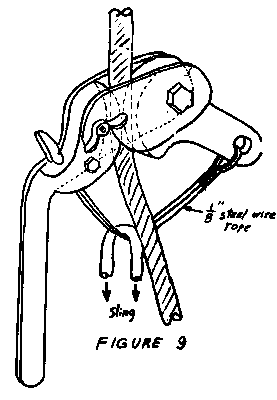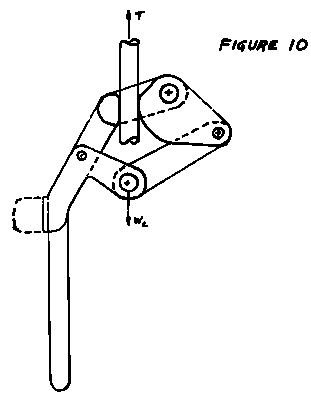Technical Details
I acquired my Varnedoe from Bill Varnedoe in 2000.
The Varnedoe is 112 mm. tall, 79 mm. wide, 57 mm. thick, and weighs 545 g. The cam is taken
from a cable puller, and is mounted between two hand-cut aluminum
side plates The anvil is also hand-cut. The assembly is held together
by two bolts. A bight of 1/8" (3.2 mm.) steel cable is looped
through the cam eye and the ends pass through holes in the anvil
and are crimped together on the other side.
Bill Varnedoe made this ascender in the 1960s. The interesting thing about this design is that the foot slings
were tied directly to the cable. Bill used two of these ascenders
to climb out of Natural Well, and the cable on one of them broke.
As Bill describes it:
The wire wore at the point it entered
the ascender, presumably from flexing, as load was applied and
removed in ascending. I used 3/8 BlueWater to attach it to my
stirrups. I had two of these as ascenders and a Jumar as a third
attachment to the standing line for a safety. (The Jumar went
to my seat harness.)
This ascender remained a curiosity for years, and I wondered why it was designed this way. It turns out that Bill was concerned with ascenders slipping. Bill wrote two articles in the Huntsville Grotto News that provided some historical insight. In the first [1], Bill proposed the interesting idea that "a good ascender is best designed by a relatively inexperienced vertical engineer," justifying the idea by the fact that it worked on the Saturn V rocket.
Bill then analyzed how ascender cams worked, and realized that "the device with the largest squeeze force is the best rope gripper. He then looked at the Jumar and Gibbs and how they generated their "squeeze force." He then decided that he wanted more.
Bill’s second article [2] focused on developing an ascender with a larger squeeze force. Inspired by how well pliers squeeze things, he patterned his first design after a nutcracker. He named his creation "VACUM," for "Vertical Assist Climb Up Machine." For you non-engineers, one always creates the acronym and then tries to find words that fit; it is never done the other way around. The resulting ascender was shown in his Figure 9. It achieved its design goal, with a squeeze force four times the user’s weight. Field tests found a problem. Alas, Bill encountered the Ultimate Rule of Engineering: Everything is Compromise. By focusing on achieving a high squeeze force, which he achieved admirably, he created an ascender that was difficult to release. Even the weight of his unloaded slings were enough to lock the ascender securely onto the rope.
Bill tried replacing the cable with rigid links, creating VACUM II. A thumb tab on one of the links provides a positive release by using the thumb on the hand holding the handle. Bill’s description is brief, and I refer the interested reader to the original articles for puzzling things out on their own.
I don't know what happened to VACUM II, but it seems that what I have is a remnant of VACUM I with the handle cut off. Holding my ascender while pouring over Bill’s articles should make for a fascinating few hours for any true vertical gear nerd, should any such person exist.
[1] Varnedoe, Bill, 1970. "Mechanical Ascender Analysis and a New Ascender." Huntsville Grotto News, XI(5), pp. 40-43.
[2] Varnedoe, Bill, 1970. "Mechanical Ascender Analysis and a New Ascender (continued)." Huntsville Grotto News, XI(7), pp. 55-58.



For far more content, use a larger monitor and a full-width window.
Hundreds of cell phone users complained and asked me to for a simpler, mobile friendly site. In particular, they wanted me to limit each page to a small number of pictures and minimize my use of text. This new site provides what they asked for.



